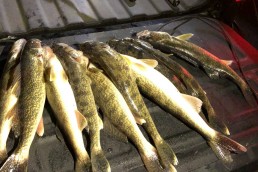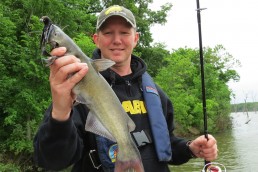Grasshoppers for Early-season Steelhead
SHARE THIS POST
Observation is the key to the outdoorsman’s success. By observing our surroundings when we participate in fishing and hunting activities, we often discover interesting facts about our quarry, and uncover hidden mysteries. I will always consider my grandfather as the ultimate observer. Whether he was fishing or hunting, he never lacked the foresight to visually scan the water or the woods. His words ring in my ears to this day: “If you look, you will learn.”
It was during a fishing trip for early-season steelhead when my grandfather discovered that grasshoppers were effective bait. He was a regular fixture on many Great Lakes tributaries when the hard-fighting, migratory rainbow trout were transported from the west coast and introduced into the region. He fished throughout the entire season, but especially relished the early-season trips, knowing that a rain event would bring steelhead into these tributaries during the warm days of summer and early fall. The presence of other anglers was unlikely, and there were many steelhead that had entered the swelled tributaries. These early-season fish were considerably more relaxed within their waters due to the lack of fishermen to provoke any wariness.
As a youngster, I clearly remember my grandfather’s description of events on a warm, late summer day, walking through a large patch of tall grass while en route to the water’s edge as startled grasshoppers jumped away from the intrusion. Pausing for a few moments in the tall grass, a grasshopper landed on his fishing rod. He was at first amused by this grasshopper that was using his fishing rod as a temporary perch; he later considered it a good omen. My grandfather’s keen eyes later scanned a corner bend in a tributary where the water was dark and deep. Looking for a visual presence of any steelhead, it occurred almost if on cue, as a big steelhead rose and boiled the surface. Obviously, something piqued its interest as it ate a food source on or just below the surface film.
The lure of food is the primary motivation for any species. The image of the grasshopper perched on his fishing rod flashed into my grandfather’s mind. All of a sudden, this steelhead readily, and without hesitation, consumed a grasshopper that had ended up in the water. My grandfather rushed back to the large patch of grass that was infested with grasshoppers, and upon conjuring his inner child, raced around the tall grass in pursuit of the leaping insects, which were clearly more agile than him. The pursuit of the quarry finally paid off and he grasped a single grasshopper within the closed cup of his hands.
Although he would have preferred a feisty live grasshopper treading the surface of the water to get the attention of the steelhead, he realized that the grasshopper would not survive the trauma of being impaled by a hook. It was also doubtful that the deceased grasshopper would continue to float with the added weight of the hook attached to its body. Figuring that many grasshoppers would not be able to fight the surface current for long before being pulled underneath the water, it was decided at that moment to attach some split shot to the line above the insect and dead-drift it below the water’s surface.
Casting a few yards upstream of where the steelhead rose, my grandfather followed the drift of the submerged grasshopper with the tip of the rod. As this underwater bait came into the zone of the steelhead, he aptly described what occurred, as if all heck was breaking loose: A strong electric jolt at the end of the line, which was quickly followed by an angry pulse of thrashing weight. The rod bent in half to accommodate the heavy fish, which seemed to hesitate for a moment before igniting its turbo boosters for a power-run upstream. As the steelhead surged upstream, it leapt out of the water several times in spectacular jumps to free itself from the hook. It was an epic battle between fish and man, which lasted nearly 15 minutes. At the end, with the big steelhead in the net, my grandfather was elated with his newly discovered bait for early-season steelhead—the grasshopper would be must-have bait for years to come.
Are you enjoying this post?
You can be among the first to get the latest info on where to go, what to use and how to use it!
Grasshoppers are common throughout this region and beyond. Nearly 11,000 species have been documented in multiple sizes and colors. All grasshoppers are ground-nesting insects, and in the midsummer months when ground temperatures have warmed, grasshoppers will emerge from the soil and live in their adult stage for two months. If temperatures stay on average, it is not uncommon for grasshoppers to be active well into October. In the Great Lakes region, green- and tan-colored grasshoppers are prevalent. No matter the size or color, grasshoppers do make excellent bait for the steelhead in our tributaries.
Bait shops don’t sell grasshoppers, so the early-season steelhead angler will have to do the task of acquiring his own supply. Grasshoppers consume leafy plant matter, and can be found in these areas. The best time to capture grasshoppers is in the early morning, following a cool night. These conditions produce dew early in the morning and the grasshoppers will be more sluggish during this time, making their capture easier; a large container can simplify the capture. A good technique is to cut some fine mesh bug netting and secure it over the top of the container with a rubber band.
Grasshoppers can be fished with either a conventional spinning rod or a fly rod. Use 6- to 8-pound-test mono or leader material. Depending on the size of the insect, a size 4 or size 6 hook is appropriate. Insert the hook behind the head, and out of the upper belly section of the grasshopper. Approximately 18 inches away from the hook, one or more split shot will be attached to the leader to aid in sinking the grasshopper. Adjust weight as necessary for difference in water depths; more depth will require more weight. To aid in strike detection, a strike indicator or small bobber can be used. A steelhead strike can vary in intensity, from subtle to vicious. A subtle strike can be so light in nature that they may not be felt. If using a strike indicator or bobber, it is very important to closely monitor what it is doing. If the indicator/bobber submerges, moves to the side or goes frontward or backward, raise the rod tip to set the hook, as it may very well be a steelhead making contact with the grasshopper.
Cast upstream into the current and allow the bait to sink and float downstream. Follow the drift with the point of the fly rod. Avoid slack line and try to keep a relatively tight line while following the drift. Cover the water thoroughly and anticipate strikes—steelhead are notorious for initial, surging power-runs when they feel the sting of the hook. It is important to let the steelhead do this first run or the fish will most certainly break the line. Keep the drag system light on the reel to ensure the fish is able to run. Fight the steelhead with the rod tip up so the rod can absorb the strength of the fish.
Grasshoppers are tested and proven steelhead bait. Remember, there is no such thing as magic bait, but this is definitely one that should be added to the early-season steelhead arsenal.
MWO
SHARE THIS POST
Did you enjoy this post?
You can be among the first to get the latest info on where to go, what to use and how to use it!
John Murray
John Murray has a passion for the outdoors. A former professional fly tyer and fishing shop owner for more than a decade, John is a member of the NYS Outdoor Writers Association and is determined to share an acquired lifetime of knowledge to help everyone become proficient hunters and anglers.



